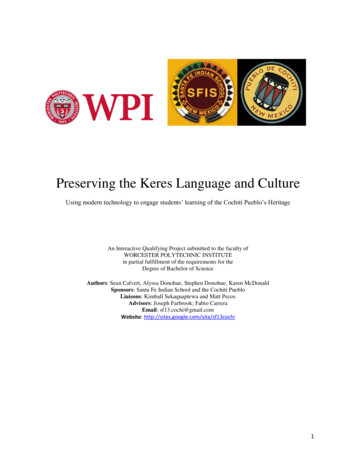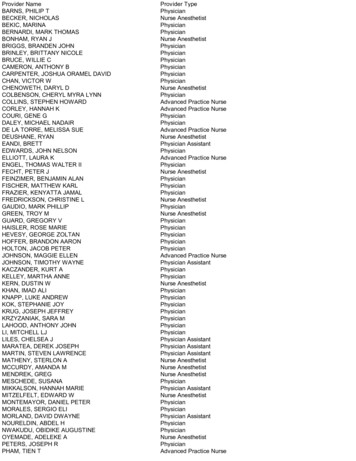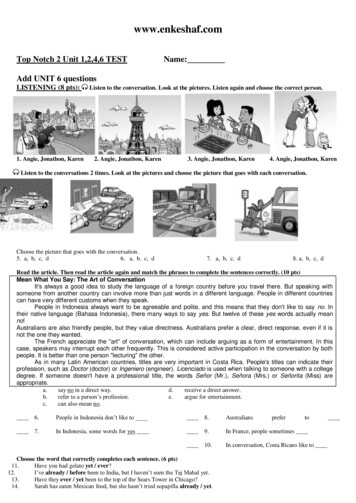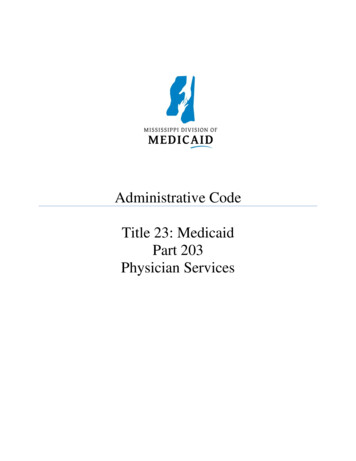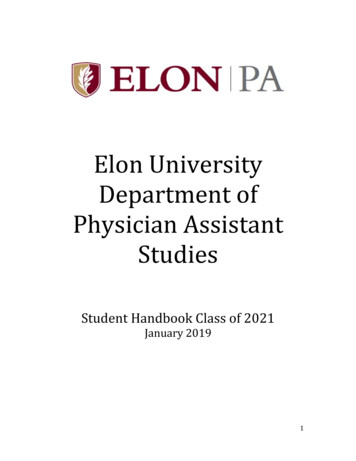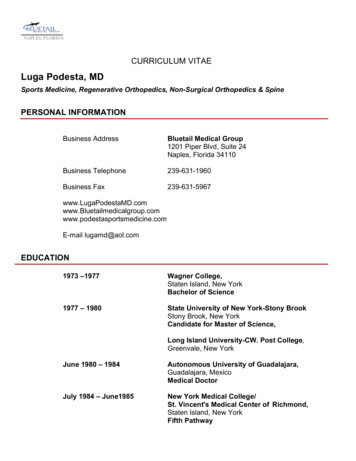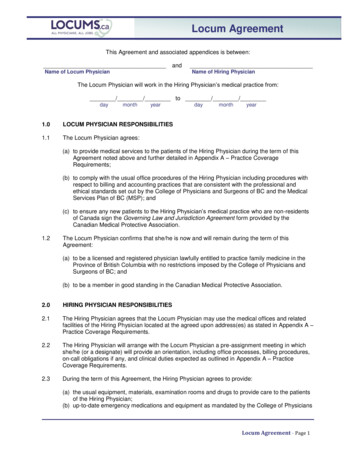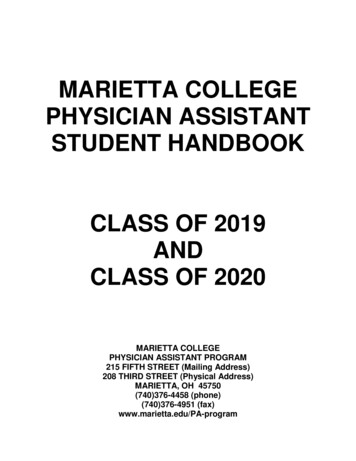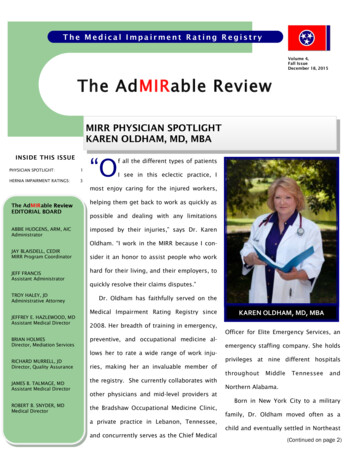
Transcription
The Medical Impairment Rating RegistryVolume 4,Fall IssueDecember 18, 2015The AdMIRable ReviewMIRR PHYSICIAN SPOTLIGHTKAREN OLDHAM, MD, MBAINSIDE THIS ISSUEPHYSICIAN SPOTLIGHT:1HERNIA IMPAIRMENT RATINGS:3“Of all the different types of patientsI see in this eclectic practice, Imost enjoy caring for the injured workers,The AdMIRable ReviewEDITORIAL BOARDABBIE HUDGENS, ARM, AICAdministratorhelping them get back to work as quickly aspossible and dealing with any limitationsimposed by their injuries,” says Dr. KarenOldham. “I work in the MIRR because I con-JAY BLAISDELL, CEDIRMIRR Program CoordinatorJEFF FRANCISAssistant AdministratorTROY HALEY, JDAdministrative AttorneyJEFFREY E. HAZLEWOOD, MDAssistant Medical DirectorBRIAN HOLMESDirector, Mediation Servicessider it an honor to assist people who workhard for their living, and their employers, toquickly resolve their claims disputes.”Dr. Oldham has faithfully served on theMedical Impairment Rating Registry since2008. Her breadth of training in emergency,preventive, and occupational medicine allows her to rate a wide range of work inju-RICHARD MURRELL, JDDirector, Quality AssuranceJAMES B. TALMAGE, MDAssistant Medical DirectorROBERT B. SNYDER, MDMedical Directorries, making her an invaluable member ofthe registry. She currently collaborates withother physicians and mid-level providers atthe Bradshaw Occupational Medicine Clinic,a private practice in Lebanon, Tennessee,and concurrently serves as the Chief MedicalKAREN OLDHAM, MD, MBAOfficer for Elite Emergency Services, anemergency staffing company. She holdsprivileges at nine different hospitalsthroughoutMiddleTennesseeandNorthern Alabama.Born in New York City to a militaryfamily, Dr. Oldham moved often as achild and eventually settled in Northeast(Continued on page 2)
Page 2MIRR PHYSICIAN SPOTLIGHTKAREN OLDHAM, MD, MBA(Continued from page 1)Ohio, where she spent her high school years.years of practice combined,” she says. “There isShe enrolled in a six-year Bachelor of Scienceno other way to learn how the complex third par-and Medical Degree program with the Universi-ty payer system really works than to participate inty of Akron and Northeast Ohio University’slegislative sessions and discuss benefits manage-College of Medicine. Upon graduating, shement with the big health insurance companies.”moved to Houston, Texas, for an anesthesiolo-Dr. Oldham then spent two years as a medicalgy residency with a focus in emergency medi-consultant for the state Chemical, Biological, Nu-Operation Iraqicine at the University of Texas’ Hermann Hos-clear Threat Rapid Response team, operatingFreedom.”pital, where she had the opportunity to workthrough the 45th Civil Support Team Nationalon Life Flight helicopters.Guard, which responds to all toxin threats and“Dr. Oldham wascalled to active dutyas an occupationalmedicine physicianwith the TN Air National Guard forAfter residency, she worked for a medicalstaffing group that serviced suburban emer-exposures, suspected or real, in the State of Tennessee.gency rooms and occupational medicine andWhile consulting, Dr. Oldham pursued a resi-urgent care clinics. She fell in love with bothdency and board certification for Occupationaltypes of work and continued working in Hou-Medicine at Meharry Medical College, but it wasston for four years before moving to Nashville,interrupted during the third year when she wasworking again for medical staffing groups ser-called to active duty as an occupational medicinevicing emergency rooms and occupationalphysician with the TN Air National Guard for Op-medicine clinics. She also pursued a Masters in(Continued on page 7)Business Administration at Cumberland University in Lebanon.During the last two years of Governor Sunquist’s Administration, Dr. Oldham served asthe Chief Medical Officer for TennCare. “Ilearned more about the business of medicineduring those two years than in all my otherThe Bradshaw Clinic, Lebanon, Tennessee
Page 3HERNIA IMPAIRMENT RATINGSJames B. Talmage, MDJay Blaisdell, CEDIROf the many types of abdominal wall hernias,TN Code 50-6-212Hernia or ruptureinguinal hernias are, by far, the most com-mon type with the preponderance of injured workers being male and, in workers’ compensation cas-(a) In all claims for compensation for hernia or rupture,es, the reported cause being heavy lifting. The AMAresulting from injury by accident arising primarily out ofGuides to the Evaluation of Disease and Injury Causation, Second Edition, indicates that genetics(family history) is the strongest risk factor inal pressure (obesity, ascites, pregnancy)and smoking have been statistically associated withabdominal wall hernias. Severe abdominal traumawith surgery is associated with incisional hernias,but “there are no good studies showing an increased risk of hernia formation in laborers.”Except for the word “primarily,” the language inTN Code 50-6-212 (see right column) has been present for decades and is a bit dated. There is nogeneral surgery definition of “radical” hernia surgery, and patients, in contrast to 50-6-212 (b), arefree to accept or reject recommended surgery.However, declining surgery without major medicalco-morbidity seriously elevating surgical risk wouldappear to make a persisting hernia not ratable. Theintent of the statute seems to be that slowly devel(Continued on page 4)and in the course and scope of the employee's employment, it must be definitely proven to the satisfaction ofthe court that:(1) There was an injury resulting in hernia or rupture;(2) The hernia or rupture appeared suddenly;(3) It was accompanied by pain;(4) The hernia or rupture immediately followed the accident; and(5) The hernia or rupture did not exist prior to the accident for which compensation is claimed.(b) All hernia or rupture, inguinal, femoral or otherwise,so proven to be the result of an injury by accident arisingprimarily out of and in the course and scope of the employment, shall be treated in a surgical manner by a radical operation. If death results from the operation, thedeath shall be considered as the result of the injury, andcompensation paid in accordance with this chapter.(c) (1) In case the injured employee refuses to undergothe radical operation for the cure of the hernia or rupture,no compensation will be allowed during the time the refusal continues.(2) If, however, it is shown that the employee hassome chronic disease, or is otherwise in such physicalcondition that the court finds it unsafe for the employeeto undergo the operation, the employee shall be paidcompensation in accordance with this chapter.
Page 4HERNIA IMPAIRMENT RATINGS(Continued from page 3)oping abdominal hernias are not covered under Tennessee workers’ compensation law in that these arelogically genetic and not “primarily” due to work activity, and that major violence (sudden, painful injury,with immediate hernia being detected) is required forwork relatedness in Tennessee.For Tennessee hernia injuries that occur on orafter July 1, 2008, the rater uses the AMA Guides,Sixth Edition, Table 6-10 (pg. 122) found in Chapter 6,“The Digestive System.” The rating scheme in the internal medicine chapter differs from that found in themusculoskeletal chapters in that the rater utilizes a“key factor” out of two or three potential variables—History, Physical Findings, and Objective Findings—toselect the impairment class. Much like grade modifiersin the musculoskeletal chapters, the other variablesare then used to modify the impairment rating withinthe impairment class. The key factor is clearly denoted with a footnote in each grid in all internal medicinechapters except Chapters 12-14, which do not utilizethe same rating scheme.In Table 6-10, “Herniation,” the authors use footnote “c” to designate “Physical Findings” as the keyfactor used to choose the impairment class. The onlyother variable is “History,” which is then used to modi-fy the grade from the default grade of “B” by subtracting the impairment class integer from the variable integer. Clinical studies are not mentioned inthe text, the table, or in any of the three examplesin Section 6.6 of the Guides. Since there are onlythree possible grades within each impairmentclass, as opposed to the five different grades foundthroughout the grids in the musculoskeletal chapters, a positive adjustment moves the grade to theright of a default for a final grade of “C.” A negativeadjustment moves the grade to the left of the default for a final grade of “A.” An adjustment greaterthan the number one cannot move the rating intoanother impairment class.(Continued on page 5)
Page 5HERNIA IMPAIRMENT RATINGS(Continued from page 4)Abdominal hernias with palpable defects or pro-A hernia is reducible if the examiner can in atrusions are usually corrected with surgery. A surgical-supine patient “reduce” or eliminate the protrusionly repaired hernia without a current palpable defect orof abdominal contents by manipulating them withprotrusion in the supporting structure of the ab-gentle digital pressure back into the abdominaldominal wall usually warrants an impairment of zerocavity. Tenderness at the site of persisting hernia ispercent. A recurrent hernia after an intra-abdominalnot an “irreducible” hernia.repair with mesh is very unusual. Consequently, mostIf the patient is at Maximum Medical Improve-hernias that are accepted in a workers’ compensationment (MMI) and still has a reducible protrusion insetting result, generally speaking, in an impairment ofthe supporting structure of the abdominal wall,zero percent. However, in the rare instances that athen the impairment class will be either one or two,recurrent hernia is present after surgery, or that thewith a whole body impairment rating ranging frompatient elects not to have surgery due to medical co-one to thirteen percent, depending on the impair-morbidity, then the resulting impairment rating mayment class and the patient’s reported Activities ofbe as high as thirty percent. This would typically beDaily Living (ADL). If the patient is at Maximumonly in huge anterior abdominal wall incisional herni-Medical Improvement and still has an irreducibleas after major abdominal surgery.protrusion in the supporting structure of the abdominal, then the impairment class will be eitherthree or four, with a whole body impairment ratingTN Bureau of Workers’ CompensationMedical Impairment Rating Registry(MIRR)220 French Landing Drive, Suite 1B,Nashville, TN 37243ranging from sixteen to thirty percent, dependingon the impairment class and the patient’s reportedActivities of Daily Living.Pain after successful repair of an abdominal wallP.615.253.5616F.615.253.5263hernia is sometimes a complaint. Remember thatCG.WCMIRProgram@tn.gov(discomfort) is not to be the basis for a Tennesseefor injuries on or after July 1, 2014, that painimpairment rating. Activities of Daily Living difficulty would have to be based on some other believa(Continued on page 6)
Page 6HERNIA IMPAIRMENT RATINGS(Continued from page 5)ble limitation to be rated. After intra-abdominal herniathese nerves from surgery would be ratable for in-repair with mesh, pain would rarely be due to injury tojuries on or after July 1, 2014. This means sharpeither the genitofemoral or the ilioinguinal nerve, asversus dull discrimination would be absent in a dis-these nerves are “deep” and covered by muscle, andtribution roughly equivalent to that depicted in thenot in the location of the typical anchor points of theGuides, Sixth Edition, Figure 16-3, page 537. Thismesh. These nerves were much more at risk of surgi-nerve injury would be ratable from Table 13-20,cal injury with the now antiquated open inguinal her-page 344, as class one, at one percent whole per-nia repairs. Presumably, only documentable injury toson impairment.(END)
Page 7MIRR PHYSICIAN SPOTLIGHTKAREN OLDHAM, MD, MBA(Continued from page 2)Dr. Oldham commanded the rescue medical-triage effort at the New Orleans airportduring the first two weeks after Hurricane Katrina.eration Iraqi Freedom. She served as Chief of Oc-also involved expediting injured airmen through thecupational Medicine, an office which included is-post-deployment healthcare system and providing VAsuing medical impairment ratings for the 118thbenefits.Airlift Wing. “I was proud to wear the uniform inDr. Oldham received a medal for valor for her mili-the service of my country,” she says. “It was atary service, and upon returning from active duty,privilege to prevent occupational injuries in thetook the Occupational Medicine Boards, becomingwide variety of duties performed by our soldiersboard certified. She returned to active duty during theand airmen. I am always humbled when caring forfirst two weeks after Hurricane Katrina as commanderones injured in the line of duty.” Part of her jobof the rescue medical-triage effort at the New Orleans(Continued on page 8)
Page 8Page 8MIRR PHYSICIAN SPOTLIGHTKAREN OLDHAM, MD, MBA(Continued from page 7)In 1998 Dr. Oldham and her husband Brad started “Circle 3 Farm Performance Quarter Horses,” whose missionis to create champion horses for the racing industry.airport, which was completely surrounded by waterscores of other pets rescued over the years. In 1998and unreachable by ground vehicles. She managedthey started “Circle 3 Farm Performance Quarterthe movements of victims brought by helicopter toHorses,” whose mission is to create champion hors-the airport and medically triaged and sent them toes for the racing industry. “We breed and train quar-appropriate care. Victims were either evacuated byter horses for barrel racing and other performancecivilian or military airplanes to hospitals in the north,events. For ten years we traveled with our youngestincluding Nashville and Memphis. “We moved an esti-son in Tennessee and surrounding states as hematedpets—raced in junior and professional rodeos. We are nowthrough the airport location during the first six days.”raising grandchildren to do the same. Our favoriteDr. Oldham lives in Lebanon, Tennessee, with herpastime is working with local children who barrelhusband, Brad, her three dogs, twelve horses, andrace and compete in various saddle club ed on page 9)
Page 9Page 9MIRR PHYSICIAN SPOTLIGHTKAREN OLDHAM, MD, MBA(Continued from page 8)We help them train, sponsor entry fees, buy helmets andcheer for them at the show. It’s wonderful to watch thesechildren care for their horses, work hard at training, andsee smiles on those faces as they finish their runs and leavethe arena on race day.”A retired paramedic and firefighter, Brad Oldham is nowa full-time farmer with a large hay-cutting business. Togeth-THE MIRR IS NOWACCEPTINGPHYSICIAN APPLICATIONS INTHE FOLLOWING AREAS OFEXPERTISE:1) Orthopaedics2) Occupational Medicine3) Physical Medicine and Rehabilitation4) Neurology5) Internal Medicine6) Ophthalmology7) Otolaryngology8) Cardiology9) Pulmonology10) PsychiatryClick HERE for an application.er Dr. Oldham and her husband have five children who arenow grown and raising their own families.(END)The TDLWD is an equal opportunity employer/program;auxiliary aids and services are available upon request.The Oldhams traveled with their youngest son, Brandon, in Tennessee and surrounding statesas he raced in junior and professional rodeos.
morbidity, then the resulting impairment rating may be as high as thirty percent. This would typically be as after major abdominal surgery. Page 5 . HERNIA IMPAIRMENT RATINGS (Continued from page 4) TN Bureau of Workers' Compensation Medical Impairment Rating Registry (MIRR) 220 French Landing Drive, Suite 1B, P.615.253.5616 F.615.253.5263
